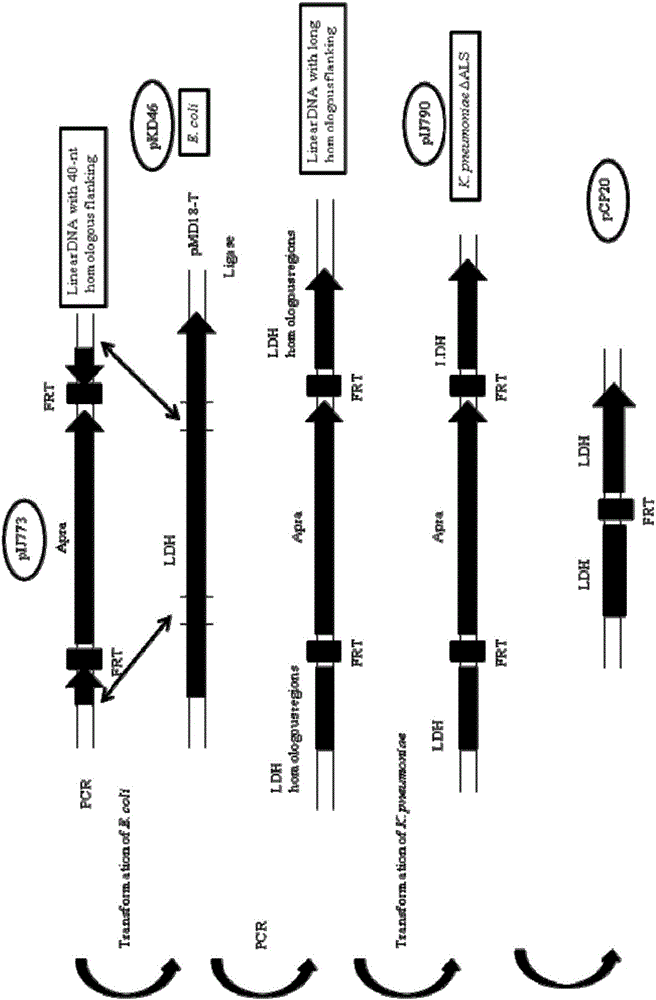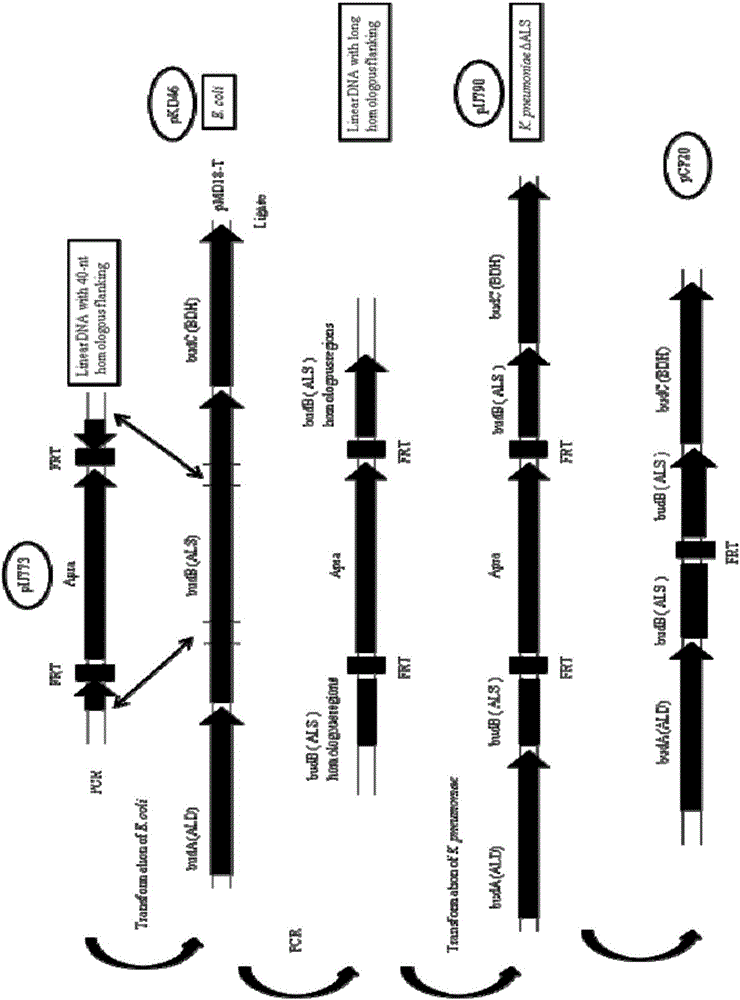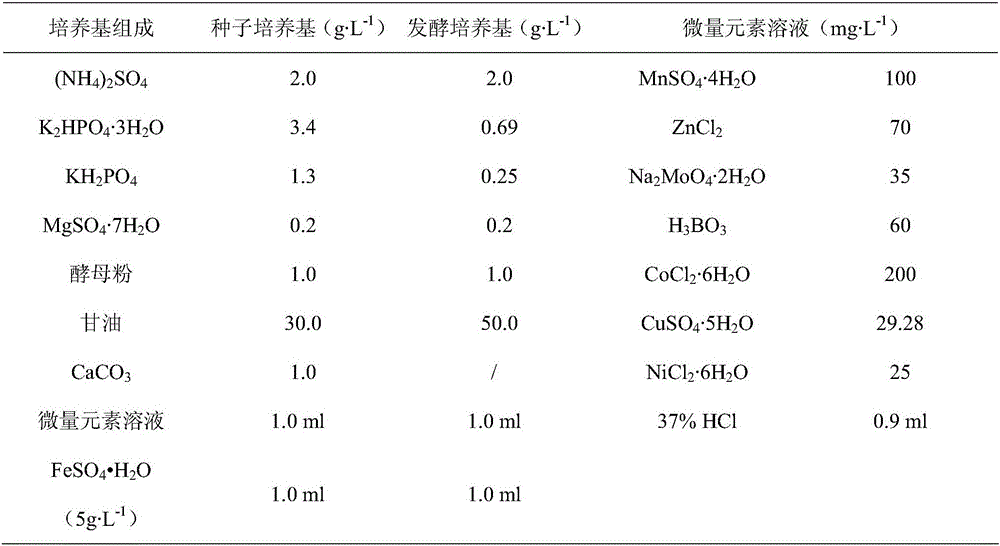Double-gene knockout engineering bacteria and construction method and application thereof in fermentation production of 1,3-propylene glycol
A construction method and dual-gene technology, applied in the biological field, can solve the problems of increased synthesis, inability to increase significantly, and increased lactic acid synthesis, and achieve the effects of increased proportion, reduced production cost, and important application prospects.
- Summary
- Abstract
- Description
- Claims
- Application Information
AI Technical Summary
Problems solved by technology
Method used
Image
Examples
Embodiment 1
[0034] Example 1: Construction of a Klebsiella pneumoniae mutant strain in which the lactate dehydrogenase gene, a key gene in the lactic acid synthesis pathway, is inactivated. The starting strain wild Klebsiella pneumoniae, the construction process is as follows figure 1 shown.
[0035] (l) Cloning of lactate dehydrogenase gene LDH
[0036] According to the DNA sequence of lactate dehydrogenase gene LDH (GenBank number: CP000647.1) design primers, PCR amplification gene sequence, primer sequence is as follows: upstream primer LDH-F: 5'-CCTCGGACATTTCCTGTTAAT-3') and downstream primer LDH- R: (5'-GGCAAACGCTGCAGCGAGCAG-3'). Using wild-type Klebsiella pneumoniae (preserved in China Center for Type Culture Collection, deposit number: CCTCC M 2011075) genomic DNA as a template, under the guidance of primers LDH-F and LDH-R, PCR amplified lactate The nucleic acid sequence of the hydrogenase gene LDH, the PCR amplification conditions are: first 95°C for 3min; then 94°C for 1min, ...
Embodiment 2
[0046] Example 2: Construction of a Klebsiella pneumoniae mutant strain in which the acetolactate synthase gene, a key gene in the 2,3-butanediol synthetic metabolic pathway, is inactivated. Build process like figure 2 shown.
[0047] The starting strain is the Klebsiella pneumoniae mutant strain of the lactate dehydrogenase gene inactivation obtained in Example 1, and the construction process is as follows: figure 2 shown.
[0048] (l) Cloning of acetolactate synthase gene ALS
[0049]According to the DNA sequence of the acetolactate synthase gene ALS (GenBank number: CP006738.1), primers were designed and the gene sequence was amplified by PCR. The primer sequences were as follows: upstream primer ALS-F: 5'-atggacaaacagtatccggtacgc-3' and downstream primer ALS-R : 5'-ttacagaatctgactcagatgcag-3'. Acetolactate was amplified by PCR using the genomic DNA of wild-type Klebsiella pneumoniae (preserved in the China Center for Type Culture Collection, preservation number: CCTC...
Embodiment 3
[0058] Example 3: Detection of lactate dehydrogenase and acetolactate synthase activities of a Klebsiella pneumoniae mutant strain in which both the lactate dehydrogenase gene and the acetolactate synthase gene are simultaneously inactivated.
[0059] Carry out the activity detection of lactate dehydrogenase gene and acetolactate synthase to the Klebsiella pneumoniae mutant strain of the lactate dehydrogenase gene and acetolactate synthase gene inactivated simultaneously of embodiment 2, take wild-type Klebsiella pneumoniae Bacteria is a control, and the specific method comprises the following steps:
[0060] 1. Activity detection of the key enzyme lactate dehydrogenase in the lactic acid metabolic pathway:
[0061] The lactate dehydrogenase gene and the acetolactate synthase gene of the key genes of the lactic acid and 2,3-butanediol metabolic pathway constructed in Example 2 were simultaneously inactivated Klebsiella pneumoniae mutant strains were subjected to lactate dehydr...
PUM
 Login to View More
Login to View More Abstract
Description
Claims
Application Information
 Login to View More
Login to View More - R&D
- Intellectual Property
- Life Sciences
- Materials
- Tech Scout
- Unparalleled Data Quality
- Higher Quality Content
- 60% Fewer Hallucinations
Browse by: Latest US Patents, China's latest patents, Technical Efficacy Thesaurus, Application Domain, Technology Topic, Popular Technical Reports.
© 2025 PatSnap. All rights reserved.Legal|Privacy policy|Modern Slavery Act Transparency Statement|Sitemap|About US| Contact US: help@patsnap.com



